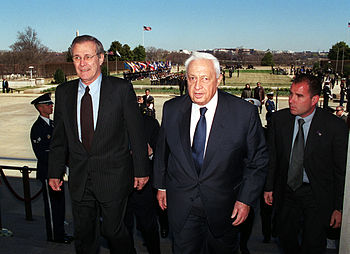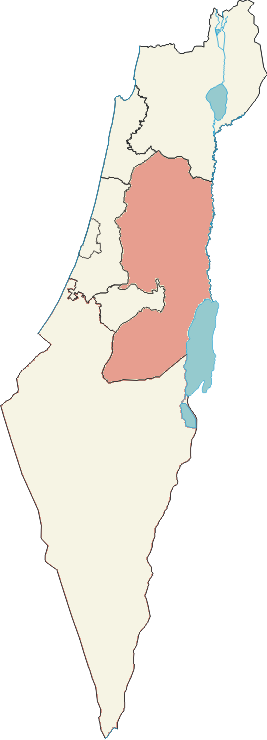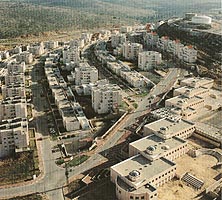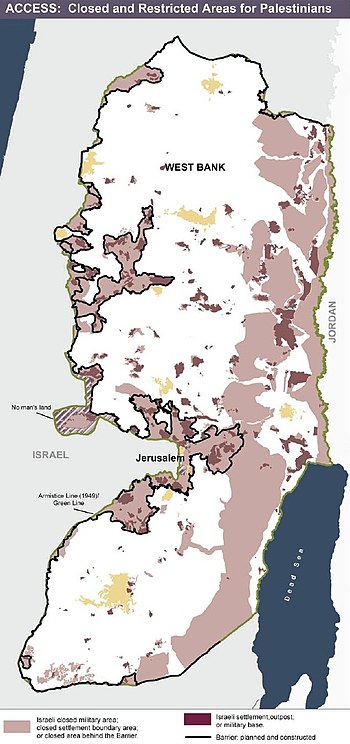| English: Israel's "Security Fence", "West Bank Barrier", is a solid wall along 5% of it's length. 10 meters high and reinforced concrete. Photo credit: Wikipedia) |
| Secretary of Defense Donald H. Rumsfeld (left), escorts Israeli Prime Minister Ariel Sharon (center) into the Pentagon at the conclusion of a full honor arrival ceremony for Sharon at the Pentagon on March 19, 2001. (Photo credit: Wikipedia) |
| Israel: Judea and Samaria District according to official Israeli regulations. Unlike other administrative districts of Israel, this district is not entirely territorial - it includes only the Israeli settlements in the West Bank (excluding East Jerusalem which was annexed to Israeli Jerusalem district). (Photo credit: Wikipedia) |
| English: Modi'in Illit, Israeli settlement in West Bank. (Photo credit: Wikipedia) |
| A detailed map of Israeli settlements on the West Bank, January 2006. Produced by the United Nations Office for the Coordination of Humanitarian Affairs - public UN source. (Photo credit: Wikipedia) |
I have said it before and I will say it again: the TV channel
Al Jazeera is screening some of the best documentaries to be seen on television
today.
I have just been catching up on their series called Rebel Architecture and this week I
streamed from the Al Jazeera website an especially brilliant episode, that I
had previously missed, dealing with the architecture performed in the West Bank
by Israeli architects.
A young Israeli architect, Eyal Weizman approached the
stuff built on the West Bank to accommodate the flood of Israeli settlers as the “architecture of Occupation”, whose
objective, he said, is to “strangulate the villages and towns on the West Bank
and to make their environment unliveable.”
He added: “This architecture is being used by architects
as a weapon. Everything built is a tactic used in the architecture of
occupation.”
He showed how, when the Israelis built houses on the
outskirts of Arab towns, they, in effect, created a wall within the city, and
in 1996 they began to build apartheid roads to serve only the Jewish occupants
and join up the various settlements. “These are the roads of apartheid, right
here,” he said.
Most of the Israeli settlements were built on the
hilltops, as measures of self-protection, and also to enable them to dominate
the surrounding countryside. Everything, down to the smallest detail, was designed
to bring to the Palestinians the message that they were under control. Road
blocks were established, special highways were built, and, even where access
was allowed through turnstiles, those turnstiles were so narrow as to ensure
that, in turning, the Arabs passing through them would be rubbed by the arms of
the turnstiles, in case they might be carrying something. He described this as
“a cruel and degrading reduction of Palestinians to make them feel they are
nothing, except their bodies.”
“We see apartheid in action here,” Weizman said. The
architecture was designed to hide the presence of the Israeli army,” which he
described as a sort of “slow violence” and an architecture of “destruction.”
The film showed what happened in 2002 when Ariel Sharon,
then Prime Minister of Israel, decided to enter the Jenin refugee camp with
bulldozers. They smashed whole streets
through, destroying houses in their way, creating new spaces broad enough to
allow tanks to enter the camp. “It was the first time the bulldozer was
integrated into the battlefield” he said.
When the recipe was repeated in Nablus it became obvious these were
regarded as laboratories for a new type of urban warfare.
Subsequently, the Israelis turned the uses made of private
and public spaces upside down: the streets, normally the public spaces, were
designed to be empty, and the warfare was carried into the homes, normally the
private spaces. The method used to enter the homes was, not through the doors,
but by driving holes through the walls, a brutal invasion of the Arab towns that Weizman described as “an invasion lasting for eight years.”
The film must have been made before the recent horrifying
attack on Gaza, but it analysed the Israeli tactic, invented in the 2008 Gaza
attack, to pretend they were conducting “a humanitarian war,” which he
described as “the saddest and most horrifying new kind of warfare that
pretended to be legal and has gone completely wrong.” He had found that between
the Israeli “warning shot”, designed to give the inhabitants time to leave, and
the actual bombing, not enough time was given for everyone to leave, and one
family he had met lost seven members when the bomb hit their house just as they were leaving. The traces left of
this house challenged, he said the Israeli claim to have conducted “a humanitarian
war” in Gaza, and what he said about 2008 surely could be multiplied many times
in relation to the most recent onslaught.
“I love this land,” said the young architect, standing on
a hilltop looking out over the landscape, “and care deeply about both of the
peoples living here, but I would have loved to practise my architecture free of
the constraints imposed by this slow process of killing the Palestinian
communities."
On the Web site, the producer of the film, Ana Naomi de
Sousa, described Weizman’s work as being at the “intersection of architecture,
with politics, violence, conflict and human rights.”
Other episodes in this six-part series deal with Vietnam,
where efforts are being made, again by a young architect struggling against
prevailing attitudes, to improve the quality of life of poor people living
along the Mekong delta through the innovative use of materials and site planning, and the other episodes give examples of similar
work from Spain, Pakistan, Brazil and Nigeria.
This is documentary film work that puts itself at the
service of the people who are its subjects, a rather rare assumption in
television, especially in the Western world.





No comments:
Post a Comment